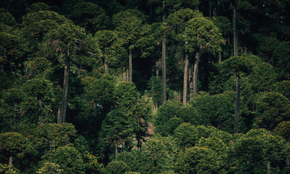Our world is changing faster than anyone predicted. Already, freshwater supplies are shrinking, agricultural yields are dropping, our forests are burning, and rising oceans are more acidic—all, in part, due to a warming climate. As our natural world changes around us, so does our way of life. Coastal home values drop as insurance premiums rise; drought reduces feed for American farmers’ cattle and water for their crops; more pollen and dust in the air aggravates asthma and allergies in kids and adults alike.
At WWF, we believe we can fight this consequential threat and build a safer, healthier and more resilient future for people and nature. We must rethink the way we produce and consume energy, food, and water; protect the world’s forests; and help people prepare for a changing world.
Achieving this future will require action by everyone, and we are already well on our way. People are using their collective voices to demand change. Businesses are making investments in clean energy, already creating local jobs and stronger economies. Communities are redesigning their roads, buildings, airports, and railroads to make them climate resilient. And nations around the world are committed to delivering on a landmark global plan to curb climate change, known as the Paris Agreement.
For decades, WWF has engaged with millions of Americans, leading businesses, and government leaders to prepare for inevitable change and reduce the emissions that drive climate change.









 Nikhil Advani
Director, Climate, Communities and Wildlife
Nikhil Advani
Director, Climate, Communities and Wildlife
 Shaun Martin
Vice President and Deputy, Climate Change
Shaun Martin
Vice President and Deputy, Climate Change
 Ryan Bartlett
Director, Climate Risk Management & Resilience
Ryan Bartlett
Director, Climate Risk Management & Resilience
 Anita van Breda
Senior Director, Environment and Disaster Management
Anita van Breda
Senior Director, Environment and Disaster Management
 Marty Spitzer
Senior Director, Climate and Renewable Energy
Marty Spitzer
Senior Director, Climate and Renewable Energy
 Christa Anderson
Director of Climate Science and Carbon Metrics, Climate Change
Christa Anderson
Director of Climate Science and Carbon Metrics, Climate Change
 Rebecca Shaw
Chief Scientist and Senior Vice President, Global Science
Rebecca Shaw
Chief Scientist and Senior Vice President, Global Science
 David Kuhn
Lead, Corporate Resilience
David Kuhn
Lead, Corporate Resilience
 Tim Juliani
Director, US Corporate Climate Engagement
Tim Juliani
Director, US Corporate Climate Engagement
 Daniel Riley
Director, International Corporate Climate Partnerships
Daniel Riley
Director, International Corporate Climate Partnerships
 Brent Loken
Global Food Lead Scientist, Global Science
Brent Loken
Global Food Lead Scientist, Global Science
 Cihang Yuan
Senior Program Officer, International Corporate Climate Partnerships
Cihang Yuan
Senior Program Officer, International Corporate Climate Partnerships
 John Holler
Climate Cooperation & Sustainable Fuels, Climate
John Holler
Climate Cooperation & Sustainable Fuels, Climate
 Cheryl Margoluis
Executive Director, CARE-WWF Alliance
Cheryl Margoluis
Executive Director, CARE-WWF Alliance
 Lucas Black
Vice President, Climate Finance
Lucas Black
Vice President, Climate Finance
 Marcene Mitchell
Senior Vice President, Climate Change
Marcene Mitchell
Senior Vice President, Climate Change